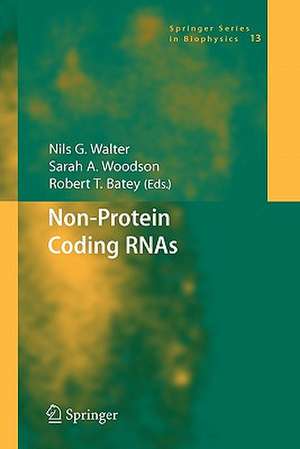Non-Protein Coding RNAs: Springer Series in Biophysics, cartea 13
Editat de Nils Walter, Sarah A. Woodson, Robert T. Bateyen Limba Engleză Paperback – 30 noi 2010
| Toate formatele și edițiile | Preț | Express |
|---|---|---|
| Paperback (1) | 1045.91 lei 38-44 zile | |
| Springer Berlin, Heidelberg – 30 noi 2010 | 1045.91 lei 38-44 zile | |
| Hardback (1) | 1230.66 lei 43-57 zile | |
| Springer Berlin, Heidelberg – 20 noi 2008 | 1230.66 lei 43-57 zile |
Din seria Springer Series in Biophysics
- 18%
 Preț: 961.72 lei
Preț: 961.72 lei - 18%
 Preț: 893.84 lei
Preț: 893.84 lei - 18%
 Preț: 958.07 lei
Preț: 958.07 lei - 20%
 Preț: 552.24 lei
Preț: 552.24 lei - 18%
 Preț: 1117.82 lei
Preț: 1117.82 lei - 15%
 Preț: 643.99 lei
Preț: 643.99 lei - 24%
 Preț: 1046.72 lei
Preț: 1046.72 lei - 18%
 Preț: 952.26 lei
Preț: 952.26 lei - 18%
 Preț: 1226.24 lei
Preț: 1226.24 lei - 18%
 Preț: 1230.66 lei
Preț: 1230.66 lei - 18%
 Preț: 938.66 lei
Preț: 938.66 lei - 20%
 Preț: 551.86 lei
Preț: 551.86 lei - 18%
 Preț: 953.65 lei
Preț: 953.65 lei - 18%
 Preț: 948.16 lei
Preț: 948.16 lei - 15%
 Preț: 645.60 lei
Preț: 645.60 lei - 18%
 Preț: 723.38 lei
Preț: 723.38 lei - 18%
 Preț: 1146.56 lei
Preț: 1146.56 lei - 20%
 Preț: 569.85 lei
Preț: 569.85 lei - 15%
 Preț: 642.51 lei
Preț: 642.51 lei - 15%
 Preț: 644.49 lei
Preț: 644.49 lei - 15%
 Preț: 649.71 lei
Preț: 649.71 lei - 15%
 Preț: 639.59 lei
Preț: 639.59 lei - 18%
 Preț: 951.29 lei
Preț: 951.29 lei - 15%
 Preț: 639.25 lei
Preț: 639.25 lei - 9%
 Preț: 872.34 lei
Preț: 872.34 lei
Preț: 1045.91 lei
Preț vechi: 1376.19 lei
-24% Nou
Puncte Express: 1569
Preț estimativ în valută:
200.14€ • 209.49$ • 166.58£
200.14€ • 209.49$ • 166.58£
Carte tipărită la comandă
Livrare economică 26 martie-01 aprilie
Preluare comenzi: 021 569.72.76
Specificații
ISBN-13: 9783642089800
ISBN-10: 3642089801
Pagini: 412
Ilustrații: XI, 398 p.
Dimensiuni: 155 x 235 x 22 mm
Greutate: 0.58 kg
Ediția:Softcover reprint of hardcover 1st ed. 2009
Editura: Springer Berlin, Heidelberg
Colecția Springer
Seria Springer Series in Biophysics
Locul publicării:Berlin, Heidelberg, Germany
ISBN-10: 3642089801
Pagini: 412
Ilustrații: XI, 398 p.
Dimensiuni: 155 x 235 x 22 mm
Greutate: 0.58 kg
Ediția:Softcover reprint of hardcover 1st ed. 2009
Editura: Springer Berlin, Heidelberg
Colecția Springer
Seria Springer Series in Biophysics
Locul publicării:Berlin, Heidelberg, Germany
Public țintă
ResearchCuprins
RNA 3D Structural Motifs: Definition, Identification, Annotation, and Database Searching.- Theory of RNA Folding: From Hairpins to Ribozymes.- Thermodynamics and Kinetics of RNA Unfolding and Refolding.- Ribozyme Catalysis of Phosphodiester Bond Isomerization: The Hammerhead RNA and Its Relatives.- The Small Ribozymes: Common and Diverse Features Observed Through the FRET Lens.- Structure and Mechanism of the glmS Ribozyme.- Group I Ribozymes as a Paradigm for RNA Folding and Evolution.- Group II Introns and Their Protein Collaborators.- Understanding the Role of Metal Ions in RNA Folding and Function: Lessons from RNase P, a Ribonucleoprotein Enzyme.- Beyond Crystallography: Investigating the Conformational Dynamics of the Purine Riboswitch.- Ligand Binding and Conformational Changes in the Purine-Binding Riboswitch Aptamer Domains.- The RNA–Protein Complexes of E. coli Hfq: Form and Function.- Assembly of the Human Signal Recognition Particle.- Forms and Functions of Telomerase RNA.- Ribosomal Dynamics: Intrinsic Instability of a Molecular Machine.- Biophysical Analyses of IRES RNAs from the Dicistroviridae: Linking Architecture to Function.- Structure and Gene-Silencing Mechanisms of Small Noncoding RNAs.
Textul de pe ultima copertă
This book assembles chapters from experts in the Biophysics of RNA to provide a broadly accessible snapshot of the current status of this rapidly expanding field. The 2006 Nobel Prize in Physiology or Medicine was awarded to the discoverers of RNA interference, highlighting just one example of a large number of non-protein coding RNAs. Because non-protein coding RNAs outnumber protein coding genes in mammals and other higher eukaryotes, it is now thought that the complexity of organisms is correlated with the fraction of their genome that encodes non-protein coding RNAs. Essential biological processes as diverse as cell differentiation, suppression of infecting viruses and parasitic transposons, higher-level organization of eukaryotic chromosomes, and gene expression itself are found to largely be directed by non-protein coding RNAs. The biophysical study of these RNAs employs X-ray crystallography, NMR, ensemble and single molecule fluorescence spectroscopy, optical tweezers, cryo-electron microscopy, and other quantitative tools. This emerging field has begun to unravel the molecular underpinnings of how RNAs fulfill their multitude of roles in sustaining cellular life. The physical and chemical understanding of RNA biology that results from biophysical studies is critical to our ability to harness RNAs for use in biotechnology and human therapy, a prospect that has recently spawned a multi-billion dollar industry.
Caracteristici
Biophysical perspective on a rapidly expanding number of non-protein coding RNAs Overview on how non-protein coding RNAs work and how biophysical techniques and other probing techniques help delineate the molecular underpinnings of RNA function Includes supplementary material: sn.pub/extras













